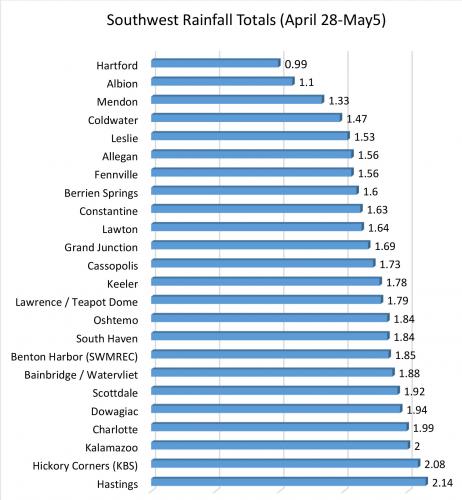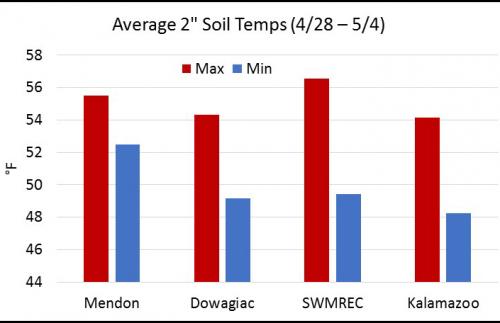Southwest Michigan field crop regional report – May 5, 2015
Wet conditions have been the story in the southwest region.

Weather
Field operations have been extremely limited over the last week due to wet conditions. Some tillage operations once again were getting underway following this weekend, but came to an abrupt halt with the return of rainfall Tuesday evening and Wednesday, May 3-4.
Wet weather continues aiding in early season weed growth. This could become more problematic with delayed burndowns due to lack of a spraying window, especially if temperatures become warm while the soils remain soggy.
The 6-10 and 8-14 day outlooks show a bit of a continuation of the recent patterns. The nearby outlook is for near normal temperatures, dipping to below normal for the 8-14 day period. Rainfall is expected to be near normal for the 6-10 day outlook, increasing to above normal in the 8-14 day outlook for southwest Michigan. We normally begin our growing degree-day (GDD) count at May 1 for corn. This would put us on average around 17 GDDs since May 1 (base 50). We are expected to be at 86 GDDs by May 11. It takes around 115-120 GDDs from planting to germination for corn.

Rainfall totals at Enviro-weather stations in southwest Michigan from April 28-May 5, 2016.

Soils graph Soil temperatures (average 2-inch depth) in southwest Michigan are somewhat less than stellar this week, April 28-May 4, 2016.
Crop reports
Early planted corn is between spike and V1. This corn was planted in the dry period of the third week of April. Most corn remains in the bag in the barn. The same issues with wet conditions that have challenged planting are causing issues with spraying.
St. Joseph County Michigan State University Extension educator Eric Anderson caught six to eight cutworm moths per night early last week. He also has a trap catch-high of 14 armyworm moths (three to four per night) over this period. I encourage growers to evaluate the “weed green status” of their fields this week and next, and keep in mind where to scout for these insect pests in the future. Remember, if we do need to treat for these pests, this will occur in about two to three weeks (around 300 GDDs base 50) from now to control the larvae. MSU Extension field crops entomologist Christina DiFonzo published an excellent article on the black cutworm situation this week, “Weeds, wet weather and cutworms.”
Some soybeans have been planted, but I have not seen fields that have emerged yet. MSU Extension soybean educator Mike Staton reminds us that lots of green materials in the field at planting time can lead to issues with seedcorn maggot. This pest lays eggs in green materials that are rotting at the surface. Since there is not a rescue treatment for seedcorn maggot damage, replant is the only after-planting option. Seed insecticide treatments or soil insecticides on corn are preventative measures that can be used to protect against these pests. Populations of seedcorn maggot tend to be higher on the higher organic matter soils and mucks, so watch these soils a little more closely for damage potential. Read more about the seedcorn maggot life cycle from Purdue University Field Crops Entomology.
Comments for both corn and soybeans: While wet conditions continue, we need to be careful that the soil is dried out enough to avoid sidewall compaction with the planters, seed furrow closure is happening in no-till operations, and we are able to create a good seedbed with tillage. Patience can help to protect stands, stand uniformity and profitability.
Wheat is growing well with the cooler than normal and wet conditions. Wheat is staging between Feekes stage 7 and stage 6, for the most part, in the lower two tiers of counties in the southwest region. Again, our herbicide window has moved beyond the 2,4-D and Banvel/Clarity window, and will most likely move beyond most herbicide application windows soon.
We are trapping for armyworms in and near wheat fields in southwest Michigan, but so far the initial numbers are low. In Indiana, where trap numbers are greater, the number of armyworm moths caught in traps has been quite high, even close to us in Elkhart County and the NEPAC station near Fort Wayne, Indiana. We will need to look for signs of armyworm feeding in a couple of weeks, but it is too early to make insecticide applications or decisions about spraying yet. The goal of an armyworm insecticide spray is primarily to protect the flag leaf, or maybe the upper two leaves from feeding injury. See DiFonzo’s “Weeds, wet weather and cutworms” article for her thoughts on armyworm control in wheat.
We have seen some evidence of powdery mildew in the lower canopy, which is to be expected given the wet conditions. We will be watching for wheat leaf diseases more as the crop progresses over the next few weeks.
Alfalfa has been growing well since getting off to a slow start because of the extreme cold temperatures after it broke dormancy this spring. Plants are around 12 inches in height. I have not seen alfalfa weevil feeding, but expect early larval feeding soon. Examine leaf tips for shot-hole type feeding injury.

Armyworm trap placed adjacent to a wheat field in St. Joseph County.



 Print
Print Email
Email


